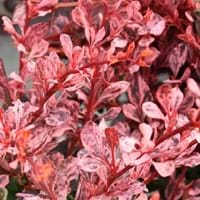Life Span
Perennial
Perennial
Origin
North America, United States, Northeastern United States, Mid-Atlantic United States, Southeastern United States, Canada
Eastern Asia, Japan
Types
Red chokeberry, Purple chokeberry
Not Available
Habitat
Anthropogenic, Boggy areas, Cliffs, Fens, Swamps, Terrestrial, Wet lands, Woodlands
Old fields, stream banks
USDA Hardiness Zone
3-8
4-8
Sunset Zone
A2, A3, 1a, 1b, 2a, 2b, 3a, 3b, 4, 5, 6, 7
A3, 2b, 3a, 3b, 4, 5, 6, 7, 8, 9, 10, 11, 12, 13, 14, 15, 16, 17, 18, 19, 20, 21, 22, 23, 24
Habit
Thicket/Colonizing
Oval or Rounded
Flower Color
Not Available
Yellow, Yellow green
Flower Color Modifier
Not Available
Not Available
Fruit Color
Purplish-black
Red orange
Leaf Color in Spring
Not Available
Light Green
Leaf Color in Summer
Not Available
Green
Leaf Color in Fall
Not Available
Purple, Orange, Burgundy, Crimson
Leaf Color in Winter
Not Available
Not Available
Leaf Shape
Elliptic
Obovate
Plant Season
Spring, Summer, Fall
Spring, Summer, Fall, Winter
Sunlight
Full Sun, Partial Sun, Partial shade
Full Sun, Partial Sun
Growth Rate
Medium
Medium
Type of Soil
Clay, Loam
Clay, Loam, Sand
The pH of Soil
Acidic, Neutral, Alkaline
Acidic, Neutral, Alkaline
Soil Drainage
Average
Average
Bloom Time
Late Spring, Early Summer
Spring, Late Spring
Tolerances
Not Available
Pollution, Drought, Salt, Soil Compaction
Where to Plant?
Ground, Pot
Ground, Pot
How to Plant?
Cuttings, Divison, Seedlings
Seedlings
Plant Maintenance
Medium
Medium
Watering Requirements
Average Water Needs, Do Not over Water, Requires regular watering
Requires regular watering during dry weather
In Summer
Lots of watering
Lots of watering
In Spring
Moderate
Moderate
In Winter
Average Water
Average Water
Soil pH
Acidic, Neutral, Alkaline
Acidic, Neutral, Alkaline
Soil Type
Clay, Loam
Clay, Loam, Sand
Soil Drainage Capacity
Average
Average
Sun Exposure
Full Sun, Partial Sun, Partial shade
Full Sun, Partial Sun
Pruning
Prune after flowering, Remove branches that rub together, Remove damaged leaves, Remove dead branches, Remove dead leaves, Remove diseased branches by the tool's blades dipped into the alcohol solution
Remove damaged leaves, Remove dead branches, Remove dead leaves
Fertilizers
10-10-10, All-Purpose Liquid Fertilizer, Apply N-P-K
All-Purpose Liquid Fertilizer
Pests and Diseases
Red blotch
Red blotch, Sunken patches
Plant Tolerance
Not Available
Drought
Flowers
Yes
Insignificant
Flower Petal Number
Not Available
Single
Foliage Texture
Not Available
Medium
Foliage Sheen
Not Available
Matte
Invasive
Sometimes
Sometimes
Attracts
Not Available
Birds
Allergy
Anaphylaxis
Not Available
Aesthetic Uses
Showy Purposes
Borders
Beauty Benefits
Good for skin
Not Available
Environmental Uses
Air purification, Food for birds, Wildlife
Air purification
Medicinal Uses
anti-cancer, Antioxidants, Cold
Anthelmintic, Antibacterial, Antiseptic, Cancer
Part of Plant Used
Fruits
Fruits, Leaves
Other Uses
Pectin
Used to make yellow dye
Used As Indoor Plant
No
No
Used As Outdoor Plant
Yes
Yes
Garden Design
Foundation, Mixed Border
Edging, Foundation, Hedges, Mixed Border, Rock Garden, Wall
Botanical Name
ARONIA melanocarpa
BERBERIS thunbergii
Common Name
Black Chokeberry
Japanese Barberry
In Hindi
Black Chokeberry Shrub
Japanese Barberry
In German
Schwarz Aronia Strauch
Thunberg-Berberitze
In French
Noir Chokeberry Arbuste
Berberis thunbergii
In Spanish
Chokeberry negro Arbusto
Berberis thunbergii
In Greek
Μαύρο Chokeberry θάμνων
Japanese Barberry
In Portuguese
Chokeberry preto Arbusto
Japanese Barberry
In Polish
Krzew aronii
Berberys Thunberga
In Latin
Lichen Frutex
Japanese Barberry
Phylum
Magnoliophyta
Magnoliophyta
Class
Magnoliopsida
Magnoliopsida
Order
Rosales
Ranunculales
Family
Rosaceae
Berberidaceae
Clade
Angiosperms, Eudicots, Rosids
Angiosperms, Eudicots
Tribe
Maleae
Not Available
Subfamily
Amygdaloideae
Not Available
Number of Species
Not Available
Not Available
Season and Care of Black Chokeberry and Rose Glow Barberry
Season and care of Black Chokeberry and Rose Glow Barberry is important to know. While considering everything about Black Chokeberry and Rose Glow Barberry Care, growing season is an essential factor. Black Chokeberry season is Spring, Summer and Fall and Rose Glow Barberry season is Spring, Summer and Fall. The type of soil for Black Chokeberry is Clay, Loam and for Rose Glow Barberry is Clay, Loam, Sand while the PH of soil for Black Chokeberry is Acidic, Neutral, Alkaline and for Rose Glow Barberry is Acidic, Neutral, Alkaline.
Black Chokeberry and Rose Glow Barberry Physical Information
Black Chokeberry and Rose Glow Barberry physical information is very important for comparison. Black Chokeberry height is 182.88 cm and width 182.88 cm whereas Rose Glow Barberry height is 90.00 cm and width 120.00 cm. The color specification of Black Chokeberry and Rose Glow Barberry are as follows:
Black Chokeberry flower color: Not Available
Black Chokeberry leaf color: Not Available
Rose Glow Barberry flower color: Yellow and Yellow green
- Rose Glow Barberry leaf color: Light Green
Care of Black Chokeberry and Rose Glow Barberry
Care of Black Chokeberry and Rose Glow Barberry include pruning, fertilizers, watering etc. Black Chokeberry pruning is done Prune after flowering, Remove branches that rub together, Remove damaged leaves, Remove dead branches, Remove dead leaves and Remove diseased branches by the tool's blades dipped into the alcohol solution and Rose Glow Barberry pruning is done Remove damaged leaves, Remove dead branches and Remove dead leaves. In summer Black Chokeberry needs Lots of watering and in winter, it needs Average Water. Whereas, in summer Rose Glow Barberry needs Lots of watering and in winter, it needs Average Water.





